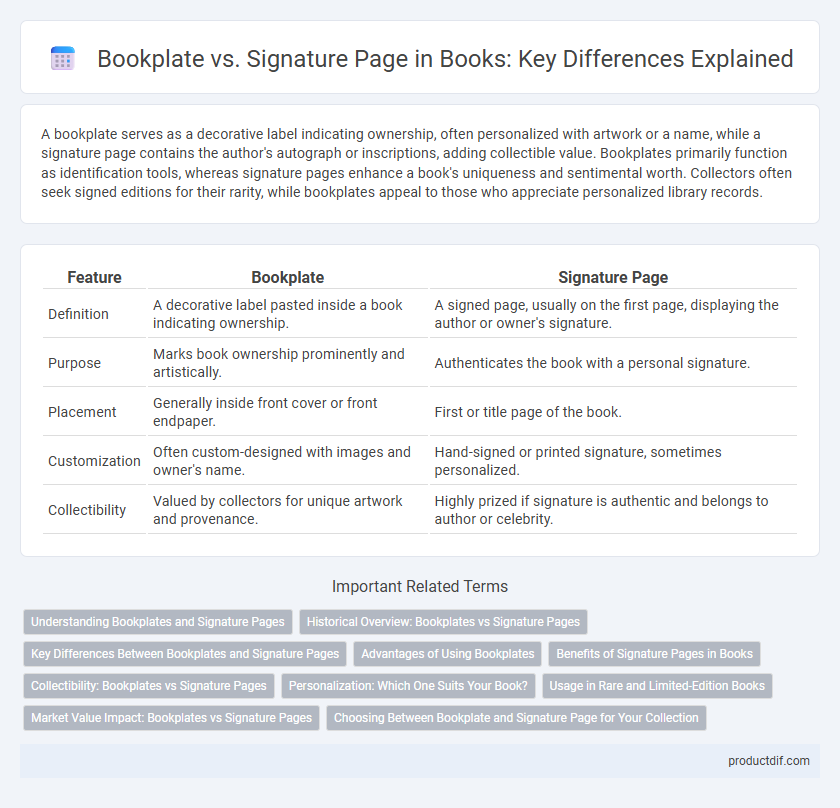A bookplate serves as a decorative label indicating ownership, often personalized with artwork or a name, while a signature page contains the author's autograph or inscriptions, adding collectible value. Bookplates primarily function as identification tools, whereas signature pages enhance a book's uniqueness and sentimental worth. Collectors often seek signed editions for their rarity, while bookplates appeal to those who appreciate personalized library records.
Table of Comparison
| Feature | Bookplate | Signature Page |
|---|---|---|
| Definition | A decorative label pasted inside a book indicating ownership. | A signed page, usually on the first page, displaying the author or owner's signature. |
| Purpose | Marks book ownership prominently and artistically. | Authenticates the book with a personal signature. |
| Placement | Generally inside front cover or front endpaper. | First or title page of the book. |
| Customization | Often custom-designed with images and owner's name. | Hand-signed or printed signature, sometimes personalized. |
| Collectibility | Valued by collectors for unique artwork and provenance. | Highly prized if signature is authentic and belongs to author or celebrity. |
Understanding Bookplates and Signature Pages
Bookplates are decorative labels affixed to the inside cover of a book to indicate ownership, often featuring personalized designs and family crests, enhancing the book's provenance and collectible value. Signature pages, by contrast, contain the author's handwritten autograph or a personal message, adding unique authenticity and emotional connection to the volume. Both elements serve distinct roles in personalizing and preserving the history of a book, appealing to collectors and bibliophiles alike.
Historical Overview: Bookplates vs Signature Pages
Bookplates, originating in the 15th century, served as decorative labels indicating book ownership and often featured intricate heraldic designs, reflecting status and identity. Signature pages, emerging prominently in the 18th century, functioned primarily as a space for an author's autograph, enhancing a book's authenticity and collectible value. Historically, while bookplates emphasized ownership and personalization, signature pages emphasized provenance and authorial connection.
Key Differences Between Bookplates and Signature Pages
Bookplates are decorative labels affixed inside the front cover of a book, personalized with the owner's name or a unique design, primarily serving as a mark of ownership. Signature pages, found at the beginning or end of a book, contain the author's autograph or personal inscription, adding collectible or sentimental value. Unlike bookplates, signature pages directly connect the book with the author, often increasing the book's rarity and appeal to collectors.
Advantages of Using Bookplates
Bookplates offer a decorative and personalized element that enhances a book's aesthetic value, making them ideal for collectors and gift-givers. Unlike signature pages, bookplates can be affixed without altering the original content, preserving the book's integrity. They also provide a durable and reusable solution for marking ownership, especially in libraries and personal collections.
Benefits of Signature Pages in Books
Signature pages in books provide a personalized and authentic touch, increasing the book's sentimental and collectible value. They serve as a direct connection between the author and reader, often including inscriptions or dedications that enhance the book's uniqueness. Unlike bookplates, signature pages are integral parts of the book, reducing the risk of detachment or damage and preserving the book's original condition.
Collectibility: Bookplates vs Signature Pages
Bookplates enhance collectibility by adding a personalized artistic element often linked to notable owners, making a book unique and historically significant. Signature pages increase a book's value by providing direct validation of authenticity and provenance from the author or an important figure. Collectors typically prioritize signature pages for their direct association with the creator, while bookplates attract those interested in provenance and ownership history.
Personalization: Which One Suits Your Book?
Bookplates offer a visually distinct way to personalize your book with custom designs and inscriptions that reflect ownership or gifting intentions. Signature pages provide a direct and intimate personalization through an author's or owner's handwritten signature or message, often enhancing the book's sentimental or collector's value. Choosing between a bookplate and a signature page depends on whether you prefer artistic expression and customization or a personal, authentic touch that connects you to the book's creator or previous owner.
Usage in Rare and Limited-Edition Books
Bookplates in rare and limited-edition books serve as personalized ownership labels, often featuring intricate designs or heraldic imagery that enhance the book's provenance and collectibility. Signature pages, typically found within limited editions, contain the author's handwritten autograph, adding unique value and authenticity to the volume. Both elements contribute significantly to the book's historical and monetary worth by affirming provenance and ensuring collectible distinction.
Market Value Impact: Bookplates vs Signature Pages
Bookplates and signature pages significantly influence a book's market value, with signed pages generally commanding higher premiums due to their direct authorial connection. Collectors often value signature pages more because they verify authenticity and personal interaction with the author, whereas bookplates, though decorative, lack this personal touch. The rarity and provenance associated with signed pages typically result in stronger market demand and elevated pricing compared to bookplates.
Choosing Between Bookplate and Signature Page for Your Collection
Selecting between a bookplate and a signature page depends on the collector's priorities for personalization and preservation. Bookplates, often designed with artistic elements and adhesive backing, offer a decorative touch without directly marking the book's pages, making them ideal for maintaining a pristine appearance. Signature pages, typically found in limited editions or autographed copies, provide authentic provenance and direct author connection but may affect the book's condition over time.
Bookplate vs Signature Page Infographic

 productdif.com
productdif.com